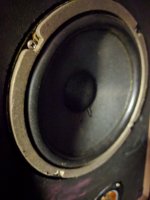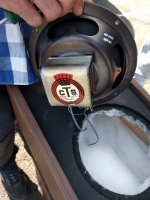Hi All.
I'm having a go at restoring 2 Loudspeakers.
They are of 2 way design featuring cTs Model 8W9R Woofers.
The Woofers are fitted with rubber surrounds.
To improve sensitivity I'm considering the removal of the rubber in preference to foam surrounds.
Removing deteriorated foam surrounds is straight forward.
How should I go about removing the rubber types without damaging the cones?
thanks
Cliff
I'm having a go at restoring 2 Loudspeakers.
They are of 2 way design featuring cTs Model 8W9R Woofers.
The Woofers are fitted with rubber surrounds.
To improve sensitivity I'm considering the removal of the rubber in preference to foam surrounds.
Removing deteriorated foam surrounds is straight forward.
How should I go about removing the rubber types without damaging the cones?
thanks
Cliff
....To improve sensitivity I'm considering the removal of the rubber in preference to foam surrounds....
How can that make enough difference to hear??
Rubber is more compliant therefore more sensitive. The difference being they are heavier and therefore lower Fs. So your little experiment is probably detrimental to over all T/SThe driver in question.
That can only happen, if at all, in a narrow band of frequencies, definitely NOT repeat NOT all over the place.
Another case where imagined advantages take ove real world performance, with a great danger of destroying or at lest downgrading the speaker in the process.
Please leave as is, the damage to improvement ratio is against you, big time.
Another case where imagined advantages take ove real world performance, with a great danger of destroying or at lest downgrading the speaker in the process.
Please leave as is, the damage to improvement ratio is against you, big time.
My 2c:
you will not improve sensitivity by much, maybe 0.5dB, sensitivity alone should not be your main objective.
when a rubber surround ages it becomes stiff and raises Fs and also changes other parameters.
this alone is a good reason to replace old rubber surrounds with foam.
how do I know? I've done it many times, specifically Vifa poly midwoofers that suffered from stiff surrounds.
also have replaced doped fabric and paper surrounds with foam and always getting a good outcome.
in all the cases T/S parameters were brought back to nominal values.
rubber is not more sensitive as some people believe.
it's heavier and the driver's sensitivity will be lower with also lower Fs.
in my book worth the effort especially with those Alnico drivers.
regarding sensitivity a phase plug instead of the dust cap can bring another 0.5 dB plus other attributes to the sound overall.
you will not improve sensitivity by much, maybe 0.5dB, sensitivity alone should not be your main objective.
when a rubber surround ages it becomes stiff and raises Fs and also changes other parameters.
this alone is a good reason to replace old rubber surrounds with foam.
how do I know? I've done it many times, specifically Vifa poly midwoofers that suffered from stiff surrounds.
also have replaced doped fabric and paper surrounds with foam and always getting a good outcome.
in all the cases T/S parameters were brought back to nominal values.
rubber is not more sensitive as some people believe.
it's heavier and the driver's sensitivity will be lower with also lower Fs.
in my book worth the effort especially with those Alnico drivers.
regarding sensitivity a phase plug instead of the dust cap can bring another 0.5 dB plus other attributes to the sound overall.
Keep in mind there are different types of foam as well as rubber. Aging deterioration is another topic. I have compared stiff foam with compliant foam, thick rubber with thin, and also vinyl rubber which is the least compliant, butyl being the most but heaviest. The important factor is to maintain original design parameters. If you change the behavior/characteristics of the surround, you change other parameters also, some more important than others.
The general design principle is that cones prone to break-up, eg. paper, use a higher damping surround to absorb energy travelling to the circumference, they preventing it returning to the centre, hence various rubber materials.
Foam is used in designs in which the cone is more self damping eg, polyprop, where this energy is damped and dissipated by the cone itself by design, on curvilinear cones, and so does need as much circumferential damping. Your paper one looks like a curved design also and will probably be a higher Q material. If you use foam it will reduce required absorption of the unwanted radiating energy and increase coloration.
Foam is prone to rotting by UV and bacteria, and has a short life, and is a PITA to me.
Rubber can be re-invigorated with the application of Caiclean Rubber rejuvenator and cleaner. This is recommended by VON Schweikert who has stated that it will give a 50 year life to the surrounds.
I have consulted ADAM about its use on my Tensor Beta bass and mid unit surrounds, and they OK'ed it, and they are fine
Foam is used in designs in which the cone is more self damping eg, polyprop, where this energy is damped and dissipated by the cone itself by design, on curvilinear cones, and so does need as much circumferential damping. Your paper one looks like a curved design also and will probably be a higher Q material. If you use foam it will reduce required absorption of the unwanted radiating energy and increase coloration.
Foam is prone to rotting by UV and bacteria, and has a short life, and is a PITA to me.
Rubber can be re-invigorated with the application of Caiclean Rubber rejuvenator and cleaner. This is recommended by VON Schweikert who has stated that it will give a 50 year life to the surrounds.
I have consulted ADAM about its use on my Tensor Beta bass and mid unit surrounds, and they OK'ed it, and they are fine
Thanks Pharos, and to all the contributors.
Naturally I'm looking for the easiest and most cost effective path to maintaining/improving sound reproduction.
CaiKleen RBR appears to be a U.S. product attracting a hefty shipping fee.
Can I ask what the active ingredients are?
Maybe I can source a locally available alternative.
Cliff
Naturally I'm looking for the easiest and most cost effective path to maintaining/improving sound reproduction.
CaiKleen RBR appears to be a U.S. product attracting a hefty shipping fee.
Can I ask what the active ingredients are?
Maybe I can source a locally available alternative.
Cliff
My 2c:
also have replaced doped fabric and paper surrounds with foam and always getting a good outcome.
in my book worth the effort especially with those Alnico drivers.
regarding sensitivity a phase plug instead of the dust cap can bring another 0.5 dB plus other attributes to the sound overall.
Thanks S.
If I did go down this path, what is the best way of tackling rubber surround removal without damaging the cone?
What is a "phase plug"?
thanks
Cliff
Dave over at Planet 10 discusses how a phase plug works as well as showing some he makes. But phase plugs come in several other shapes I think one company just uses a spark plug socket and our friends at lother have some that look almost like a mushroom.
planet_10 hifi
planet_10 hifi
Thanks S.
If I did go down this path, what is the best way of tackling rubber surround removal without damaging the cone?
What is a "phase plug"?
thanks
Cliff
It depends on many things Cliff.
Some rubber surrounds will peel off easily with a bit of help with a sharp hobby knife.
With paper cones sometimes I had to cut it off carefully around the cone circumference and clean as much of the remains of the old surround as possible without damaging the cone.
It is a time consuming exercise and also requires a lot of attention, sharp eyes and good light. I never use chemicals, too great a risk of causing other problems that cannot be seen and rectified immediately.
Phase plugs usually attach to the polepiece of the driver, some people glue them, I only use the magnetic properties of the pole piece to hold the P/P in place. But that is because I only use wooden P/Ps with 2 - 3 little screws driven into the rear end of the P/P.
I know some people have used metal sockets as P/Ps, but that's wrong. The socket changes the magnetic properties of the driver in a very unpredictable way so I do not advise it.
As for what is a P/P, check Dave's (Planet10) web site for info. Also Tony Gee has an article on the topic with some test results.
In general, and I am happy to be corrected, P/Ps improve the performance of a given driver in the mid and top of its range, and that's why they are most of the time used with drivers performing midrange duties. Which definitely includes 2 way speakers.
To my ears P/Ps work almost all the time improving clarity and making the sound more cohesive.
I've used P/Ps initially with poly cones, and in the last few years mostly with paper cones always with great results (to my ears of course).
If you check SEAS you'll notice that a great number of their midwoofers employ P/Ps. And SEAS know a thing or two about speaker design.
- Home
- Design & Build
- Construction Tips
- Removing Rubber Speaker Surrounds

